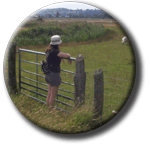The Countryside and
Rights of Way Act 2000
Links to sections explaining main sections of the Act:
• Access
to Open Country
• Public
Rights of Way
• Nature Conservation
• Areas of Outstanding
Natural Beauty
• Miscellaneous Provisions
• Financial Implications
In 1999 the government proposed
a new right of access for those on foot to certain types of land. This is often
known as 'The Right to Roam' although this title is not  official
and can be somewhat misleading. A statement of the Government's access proposals
was published in March 1999, entitled Access to the Countryside in England and
Wales: The Government's Framework for Action. The framework was developed in
the light of responses to the public consultation paper, Access to the Open
Countryside in England & Wales, published in February 1998, and the results
of a study of the economic, environmental and social benefits and costs of different
approaches for improving access to open countryside.
official
and can be somewhat misleading. A statement of the Government's access proposals
was published in March 1999, entitled Access to the Countryside in England and
Wales: The Government's Framework for Action. The framework was developed in
the light of responses to the public consultation paper, Access to the Open
Countryside in England & Wales, published in February 1998, and the results
of a study of the economic, environmental and social benefits and costs of different
approaches for improving access to open countryside.
The Act received Royal Assent on 30 November 2000 and covers
four main areas of interest: Access to Open Country, Public Rights of Way, Nature Conservation and Areas of Outstanding Natural Beauty. The Act is a collection of
somewhat loosely related subjects, not all of which were ready for immediate
implementation at the time the Act was passed. Various parts of the Act came
into force over the subsequent years, up until 2004. This was done by the making
of 'Commencement orders'.
The purpose of the Act is to create a new statutory right
of access on foot to certain types of open land, to modernise the public rights
of way system, to strengthen nature conservation legislation, and to facilitate
better management of AONBs. There are provisions for local authorities to establish
byelaws and give greater powers of enforcement to a variety of relevant bodies.
It seeks to balance the new rights with responsibilities on all parties, and
codes of practice have been produced to explain these to landowners and users
(see the government websites below).
This part of the Act was introduced gradually and there
were regular changes to the situation, and variations from region to region.
To find out more visit the following websites:
Countryside
Access is the government website for online public maps of access land
and public information about the new right of access. The online maps also
contain up-to-date information of any restrictions or closures). This website
also contains detailed of the new Countryside Code and general information
and helpful advice on enjoying access to the countryside.
Open Access is the government
website for information about access rights under CROW for land managers.
The Act provides for a new right of access on foot to areas
of open land comprising:
• Mountain (land over 600 metres)
• Moorland
• Heath
• Downland
• Registered common land
There are provisions to consider extending the right in the
future to coastal land, but not woodland despite some early publicity suggesting
this.
There are various restrictions, and definitions which place
certain limits on the right of access, and the rights will not come totally
into effect until the mapping exercise is completed, estimated to be late
2005. Most of the responsibility for identifying, mapping and administering
the process of managing the new rights falls to Natural England (in England),
the Countryside Council for Wales, (in Wales), assisted in part by the National
Park Authorities. Although there are powers available to Local Authorities,
there are no duties for them in respect of Open Access. However, there are
several powers for the ‘access
authority’ (which outside National Parks
is the local highway authority) and these are likely to become an issue for
debate amongst the Local Access Fora which must also be set up, under the
provisions of the Act, by the access authority.
Before the open access became generally available, the former
Countryside Agency (in England) carried out an extensive mapping exercise
to clearly identify all the qualifying land, and clarifying the type of access
land. Pilot studies were being carried out in two areas of the country and
based on these experiences, the rest of the country was mapped on a rolling
programme. The rights of access are similarly being introduced in a sequential
manner, region by region, the first regions being finally completed in May
2004, and the last ones in November 2005. Now the final (conclusive)
maps are prepared and published, they are subject to review every
ten years, although that period my be changed by regulation.
There are a number of specific actions, both on the part of
landowners and users, which constitute offences, and the access authority can
also make byelaws or carry out works to improve the management of access land.
Wardens can also be appointed to assist landowners and the public by ensuring
compliance with byelaws and exclusions, and by offering advice and assistance.
There are a number of reasons why access may be restricted
from some areas, and these include nature conservation concerns, heritage
preservation, avoidance of fire, or other danger to the public, defence,
or for activities which are incompatible with open access. Some of the restrictions
are available at the request of the landowner, and others on direction from
Natural England or the Secretary of State, and may be temporary or permanent.
Most proposed restrictions will be subject to debate by the Local Access
Fora and may be revoked or varied at intervals.
There are no provisions for compensation to landowners whose
land becomes the subject to the right of access, but under certain circumstances,
compensation my be payable for other reasons. If it is necessary to create new
public rights of way to reach areas of open access, or if damage is sustained
to any person in the exercise of powers conferred by the Act, there may be an
entitlement to some compensation.
The major implication for public rights of way is that highway
authorities are required to produce a Rights of Way Improvement Plan for their
area, taking into account the needs of the public in terms of recreation, exercise,
and enjoyment of the countryside, and considering the particular needs of less
able people. This needs to include a statement on how the improvements are to
be secured. The plan has to be written within 5 years, and reviewed at intervals
of 10 years, and a prescribed consultation process has to be followed.
 Another
significant implication of the Act is that the Definitive Map is to be closed
to claims for historical rights of way in 2026, requiring extensive research
to be undertaken in the meantime to ensure that highway rights are not inadvertently
lost. The Countryside Agency has set up a national scheme in England to do this
on a rolling basis, called Discovering
Lost Ways. It is expected to cover all of England by 2012.
Another
significant implication of the Act is that the Definitive Map is to be closed
to claims for historical rights of way in 2026, requiring extensive research
to be undertaken in the meantime to ensure that highway rights are not inadvertently
lost. The Countryside Agency has set up a national scheme in England to do this
on a rolling basis, called Discovering
Lost Ways. It is expected to cover all of England by 2012.
Any authority which has not completed the review of Roads Used
as Public Paths can now re-classify them as Restricted
Byways, which will be available for use on foot, horseback, cycle and non-motorised
vehicles.
Diversions and extinguishments of paths are possible in a number
of circumstances; for example to protect SSSIs, for the protection of schools
and for safety in certain areas, and landowners now have the right to apply
for an order. They can also make temporary diversions of paths in order to carry
out certain works, and it is also possible to make Traffic Regulation Orders
for nature conservation purposes.
Authorities must take into account the needs of less able people
when authorising stiles and gates to allow easier access. Measures to make prosecution
for various obstructions easier and more effective are also included, together
with provisions for allowing the public to serve notice on the local authority
for failing to take appropriate action.
Offences relating to the mis-use of public rights of way by
vehicles are addressed, as is the question of vehicular use over registered
common land.
The importance of biodiversity conservation is given a statutory
basis, requiring government departments to have regard for biodiversity in carrying
out its functions, and to take positive steps to further the conservation of
listed species and habitats.
The protection of SSSIs, already established in the Wildlife
and Countryside Act ,
is strengthened giving greater power to Natural England to enter into management
agreements, to refuse consent for damaging operations, and to take action where
damage is being caused through neglect or inappropriate management.
,
is strengthened giving greater power to Natural England to enter into management
agreements, to refuse consent for damaging operations, and to take action where
damage is being caused through neglect or inappropriate management.
Local Authorities have a statutory duty to further the conservation
and enhancement of SSSIs both in carrying out their operations, and in exercising
their decision making functions.
The Act strengthens legal protection for threatened species
and brings up to date the Wildlife and Countryside Act 1981. This assists in
bringing offenders to justice, and provides for stronger penalties.
The Act clarifies the procedure and purpose of designating AONBs,
which was originally set out in the National Parks and Access to the Countryside
Act 1949, and amended in the Environment Act 1995, resulting in a degree of
fragmentation. The consolidation of these provisions improves its effectiveness
and its impact.
The Act requires local authorities in whose areas AONBs are
located to prepare and publish a management plan for the area. If one already
exists, the local authority may decide whether to review and adopt an existing
one, or to produce a new one of their own. This procedure had to result in a
plan being adopted as a statutory plan by 31st March 2004. Extensive consultation
as set out in the Act must be undertaken, and once published, the Plan must
be reviewed every five years.
Local authorities, Ministers of the Crown, Public bodies (such
as government agencies), statutory bodies and any person holding public office
will also have a duty to have regard to the purpose of conserving and enhancing
the natural beauty of the AONB in exercising or performing their functions.
Provision is made in the Act for larger AONBs, covering several
local authority areas, to apply to the Secretary of State for permission
to set up a Conservation Board to manage the AONB, taking over certain agreed
functions from the local authorities. The funding for such bodies would
come from a combination of places, including the Secretary of State, Natural
England and the constituent local authorities.
This part of the Act sets out the requirement for highway authorities
and National Park Authorities to set up and run Local Access Forums (or more
strictly Fora). These bodies are statutory consultees for a variety of purposes
set out elsewhere in the Act.
The Act amends the Wildlife and Countryside Act 1981 to enable
management agreements to be entered into by a wider number of authorities (e.g.
the new Conservation Boards) and in respect of any land, whether or not it is
in the countryside.
The remaining provisions clarify the situation of the Norfolk
and Suffolk Broads and the Scilly Isles, and also the position of Village Greens
in terms of the registration of Common Land.
There are 14 Schedules which form part of the Act and which
regulate the manner in which it is applied, and, as stated before, a number
of regulations have yet to be made which enable further provisions to take effect.
The government undertook a financial study, called a regulatory
impact assessment, to determine the likely cost of implementing the provisions
of the Act. With respect to the local authority responsibilities, the cost of
implementing the rights of way duties has resulted in an increase in the Standard
Spending Assessment of the Council as a whole.
The open access provisions officially had no financial implications
for local authorities, other than the setting up and operating of Local Access
Fora. The responsibilities in relation to part III of the Act, relating to Nature
Conservation and Wildlife Protection, fall to Natural England (in England) and
the funding was therefore directed to them.
Note: This article is directly relevant to England and
Wales only. It refers to Natural England in many instances
but in parts of the UK outside England other bodies may have the same or a
similar responsibility. In Wales this is CCW.
This summarising the provisions of the Act is reproduced
(with some amendments and updates by others) by kind permission of the author,
Helen Slade, formerly AONB Officer for the Isle
of Wight AONB (originally written March 2001).

 official
and can be somewhat misleading. A statement of the Government's access proposals
was published in March 1999, entitled Access to the Countryside in England and
Wales: The Government's Framework for Action. The framework was developed in
the light of responses to the public consultation paper, Access to the Open
Countryside in England & Wales, published in February 1998, and the results
of a study of the economic, environmental and social benefits and costs of different
approaches for improving access to open countryside.
official
and can be somewhat misleading. A statement of the Government's access proposals
was published in March 1999, entitled Access to the Countryside in England and
Wales: The Government's Framework for Action. The framework was developed in
the light of responses to the public consultation paper, Access to the Open
Countryside in England & Wales, published in February 1998, and the results
of a study of the economic, environmental and social benefits and costs of different
approaches for improving access to open countryside. Another
significant implication of the Act is that the Definitive Map is to be closed
to claims for historical rights of way in 2026, requiring extensive research
to be undertaken in the meantime to ensure that highway rights are not inadvertently
lost. The Countryside Agency has set up a national scheme in England to do this
on a rolling basis, called
Another
significant implication of the Act is that the Definitive Map is to be closed
to claims for historical rights of way in 2026, requiring extensive research
to be undertaken in the meantime to ensure that highway rights are not inadvertently
lost. The Countryside Agency has set up a national scheme in England to do this
on a rolling basis, called